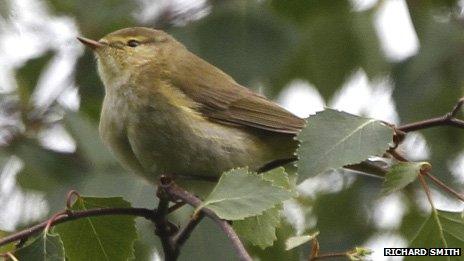Record number of unusual birds seen in Wales last year
- Published
.jpg)
Marmora's warbler taken at the Blorenge mountain in Monmouthshire in June 2010
A record number of unusual birds were spotted in Wales last year, including two species not seen before.
A total of 136 scarce and rare birds were reported for 2010, with accurate enough descriptions to be added to Welsh Ornithological Society records.
An Iberian chiffchaff, usually found in Spain and Portugal, spent five weeks in Wentwood Forest, near Newport in May.
In June, a marmora's warbler from the Mediterranean was found on the Blorenge mountain near Abergavenny.
The previous high was 109 birds in 2008.
The finds were recorded by the Welsh Records Panel, which is part of the Welsh Ornithological Society.
Panel secretary Jon Green said: "We're seeing a growing trend for continental waterbirds occurring in Wales."
Among birds spotted were:
Three great white egrets (one of which was ringed as a nestling in France's Loire Valley
Five cattle egrets
Four glossy ibis
Single squacco and purple herons.
Four White Storks, two of which were photographed by a farmer following his plough in Pembrokeshire.
Among the other highlights were Wales' second white-throated sparrow on Bardsey Island in Gwynedd and second red-flanked bluetail on Skomer Island in Pembrokeshire.
There was also a bobolinks which made it from North America to Skomer and Glamorgan in the autumn.

The Iberian chiffchaff is usually found in Spain and Portugal
Another species spreading successfully is the woodlark, a bird that just a decade ago was restricted to heathland and farmland in southern and eastern England, but has been spotted in Llandudno and Skomer Island.
Bearded Tits bred in north and south Wales last year and is doing well enough to be removed from the list of scare birds.
But two formerly widespread breeding species in Wales were recorded just once last year.
A corn bunting was seen on Bardsey Island and a red-backed shrike near St David's in Pembrokeshire. Until the middle of the 20th Century, both species bred in most Welsh counties.
- Published9 June 2010